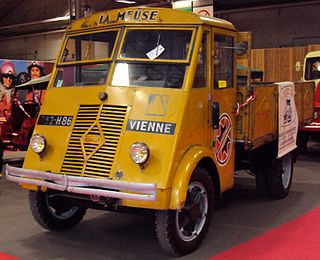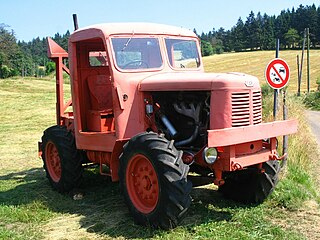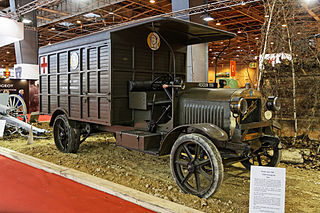
The Automitrailleuse de Reconnaissance Renault Modèle 1933 was a French light cavalry tank developed during the Interbellum and used in the Second World War.

The Voie Sacrée is a road that connects Bar-le-Duc to Verdun (Meuse), France. It was given its name because of the vital role it played during the Battle of Verdun in World War I.

An artillery tractor, also referred to as a gun tractor, is a specialized heavy-duty form of tractor unit used to tow artillery pieces of varying weights and calibres. It may be wheeled, tracked, or half-tracked.

The Renault UE Chenillette is a light tracked armoured carrier and prime mover produced by France between 1932 and 1940.

The Lorraine 37L or Tracteur de ravitaillement pour chars 1937 L, is a light tracked armoured vehicle developed by the Lorraine company during the interwar period or interbellum, before the Second World War, to an April 1936 French Army requirement for a fully armoured munition and fuel supply carrier to be used by tank units for front line resupply. A prototype was built in 1937 and production started in 1939. In this period, two armoured personnel carriers and a tank destroyer project were also based on its chassis. Mainly equipping the larger mechanised units of the French Infantry arm, the type was extensively employed during the Battle of France in 1940. After the defeat of France, clandestine manufacture was continued in Vichy France, culminating in a small AFV production after the liberation and bringing the total production to about 630 in 1945. Germany used captured vehicles in their original role of carrier and later, finding the suspension system to be particularly reliable, rebuilt many into tank destroyers of the Marder I type or into self-propelled artillery.
Korn et Latil was a French automobile manufacturer established in 1898 at Marsaille. In 1909, after moving to Levallois-Perret being reincorporated and later bankrupt, it was succeeded by Latil.

The Breton-Prétot machine was an experimental wire-cutting device developed in France from November 1914. It was developed by Mr. Prétot, engineer, and Jules-Louis Breton, member of the French National Assembly.
Automobiles Industriels Latil, commonly known as Latil, was a French manufacturer of commercial and military vehicles created to manage the assets of the defunct Compagnie Française d'Mecánique et d'Automobiles, to market Georges Latil's avant-train Latil, an early front-wheel drive system. The company was established in 1909 by entrepreneur Charles Blum as Charles Blum & Cie. It started to use Automobiles Industriels Latil in the 1910s as a trading name. The company started to produce military vehicles by the 1910s and commercial ones in great numbers by the end of World War I. In 1928, the company adopted its trading name as its legal name. It was dissolved in 1955 after being merged into the Saviem group.

The Renault AHx was a range of light/medium trucks with carrying capacities from 2 to 5 tonnes manufactured by Renault between 1941 and 1947. Various versions were used in World War II by the German forces.
The Panhard K 101 is a forward control truck aimed at military and commercial use produced between 1937 and 1940 by the French manufacturer Panhard.

The Tracteur Panhard-Châtillon (French pronunciation:[tʁaktœʁpanaʁ ʃatijɔ̃] was a conventional-cabin, all-wheel drive truck produced between 1911 and 1918 by the French manufacturer Panhard. It was one of the first all-wheel drive trucks used by the French military.
The Renault AGx was a range of light/medium/heavy trucks produced by the French manufacturer Renault between 1937 and 1941. The range includes both conventional and forward control trucks.

The Renault ACx and ADx is a range of light/medium trucks produced by the French manufacturer Renault between 1935 and 1940. From the range derived some buses.

The early 1930s Renault commercial vehicles were a range of modular chassis produced by Renault, sold under various configurations, primarily trucks, buses and coaches. The range was the first from Renault to get diesel engines and it abandoned previous design styles from the company. The range was gradually replaced from 1935 onwards by the ACx and ADx light range, the ABx medium range and the ZP bus/coach.

The Renault ABx is a range of medium-duty forward control trucks produced by Renault between 1934 and 1937. The range was made of the ABF and the ABG. Renault also developed a bus/coach called the ZP using the same cabin.
The Military Division was a Vichy French infantry formation in 1940-1942, during World War II. The divisions were numbered according to the military regions. The Vichy French Military Division had a near-identical organisation as the French Infantry Divisions of 1939-1940, but with the restrictions of the Armistice of 22 June 1940 imposed them. The whole Army of Vichy France, except for the Garde, was demobilized on 27 November 1942 after Case Anton.

The Latil H14 TL10 is an all-wheel drive agricultural and forestry tractor produced by Latil and later Saviem from 1947 to 1962 through various evolutions. It was replaced by the Saviem TL21/22/23 range.
The Latil H14 and H16 A1 is a range of medium-duty/heavy-duty trucks with a forward control design for road transport produced by the French manufacturer Latil and later Saviem. The Latil H14 and H16 A1 were the last road trucks of Latil origin produced by Saviem. The range was heavily modularised, with standardised pieces and mostly using just a couple of engines throughout its run.

The Latil KTL is an all-wheel drive tractor produced by the French manufacturer Latil. It was used as a commercial as well as a military tractor.

The Berliet CBA is a series of medium-duty trucks with chain drive, initially for the military and later also for commercial use. It was produced by the French manufacturer Berliet from 1913 to 1932, and was one of the most used trucks in World War I. It was replaced by the Berliet GD series.















